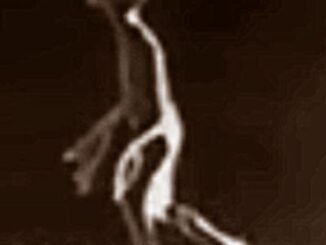The winners of the 2024 European Wildlife Photographer of the Year awards have been announced. Launched in 2001, this competition is one of the most prestigious in modern nature photography. This time, it drew submissions from photographers across 38 countries, with a total of 18,000 images entered.
Organized by the GTD (Gesellschaft für Naturfotografie), the competition features finalists across nine categories: Birds, Mammals, Other Animals, Plants & Fungi, Landscapes, The Underwater World, Man and Nature, Nature’s Studio, and two Young Photographer categories (up to 14 years and 15–17 years). In addition, there are two special categories: the Fritz Pölking Prize and Junior Prize, as well as the Rewilding Europe Award.
Be sure to scroll down to explore the incredible selection of images from the finalists of the contest and to learn more about the participants and their winning photographs.
Man And Nature, Runner-Up: New World By Grzegorz Długosz
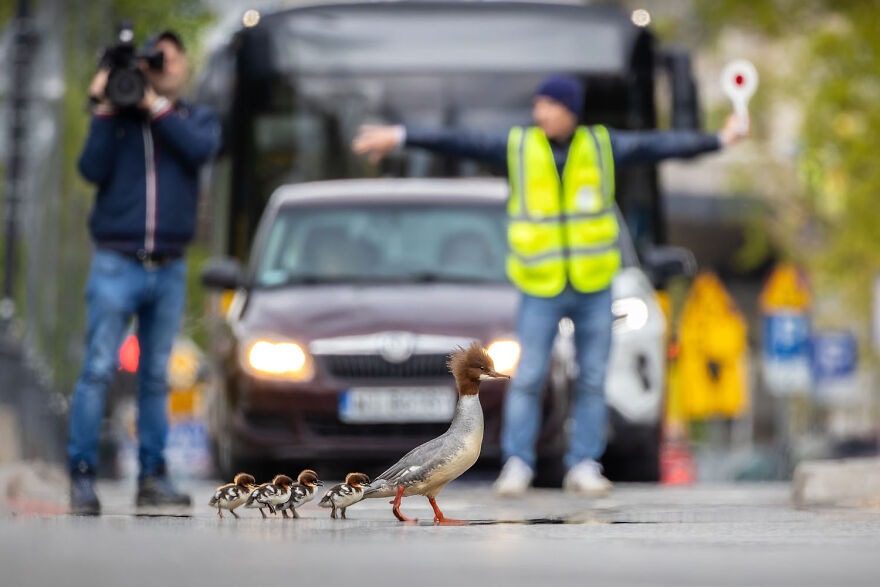
For common mergansers (Mergus merganser) in Warsaw, the breeding season has become rather stressful. Ducklings hatch in a park about one kilometre away from the river Vistula. Each female duck has to relocate its ducklings to the river as quickly as possible because this is the only place in the park with food and shelter. To get to the river, the ducks must cross two canals and go through three underground passages created especially for this purpose. The final obstacle is a wide six-lane motorway. Every year, a group of volunteers help the ducks cross this dangerous road by holding up traffic. This image shows a duck crossing a smaller road because it refused to use the nearby dark underground passage. The volunteer blocks traffic while the cameraman captures the scene. Let’s hope there will always be enough volunteers to stop traffic for ducklings.
We reached out to, whose captivating photograph earned him a winning spot in the GDT’s prestigious awards. Our conversation centered on the awe-inspiring natural phenomenon of monarch butterfly migration, and the photographer graciously agreed to answer our questions.
To start, Rojo shared his observations from the time he spent in the forest, watching the butterflies: “I’ve been working with monarchs for 20 years, but each visit teaches me something new.” The photographer continued: “On one of my recent trips for this assignment, I witnessed firsthand the different strategies birds use to prey on monarchs during hibernation—something that is rare to see and even harder to photograph. Monarchs are toxic because, as caterpillars, they feed on milkweed and store the plant’s toxins as their first line of defense. These toxins are stored in the scales that cover their wings and bodies. However, some birds have learned to cope with the effects of the toxins. Grosbeaks are gluttonous and eat the abdomen whole, including the toxic scales, but after feeding for a while, they must stop because they start feeling sick. Tanagers and orioles, on the other hand, are like surgeons—they use precise incisions in the abdomen to extract the nutritious fat while avoiding the toxic scales, allowing them to feed for longer periods.”
Birds, Runner-Up: Angry Bird By Kjell Vikestad
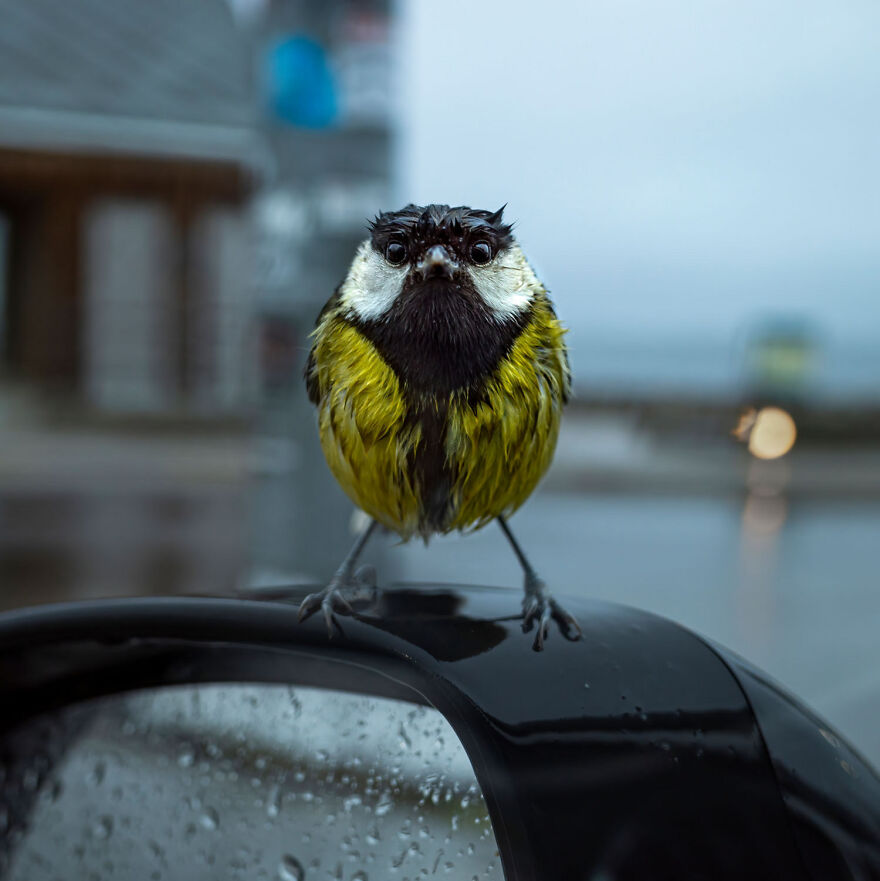
At the ferry terminal in Hella, Norway, the birds have become accustomed to being fed bread crumbs by waiting motorists. Conditioned to be fearless, they often land directly on cars hoping for a small snack. Although I had nothing to offer, I took the opportunity to take a few shots of this wet and hungry great tit (Parus major).
Man And Nature, Highly Commended: Healing Therapy By Gerard Carbonell
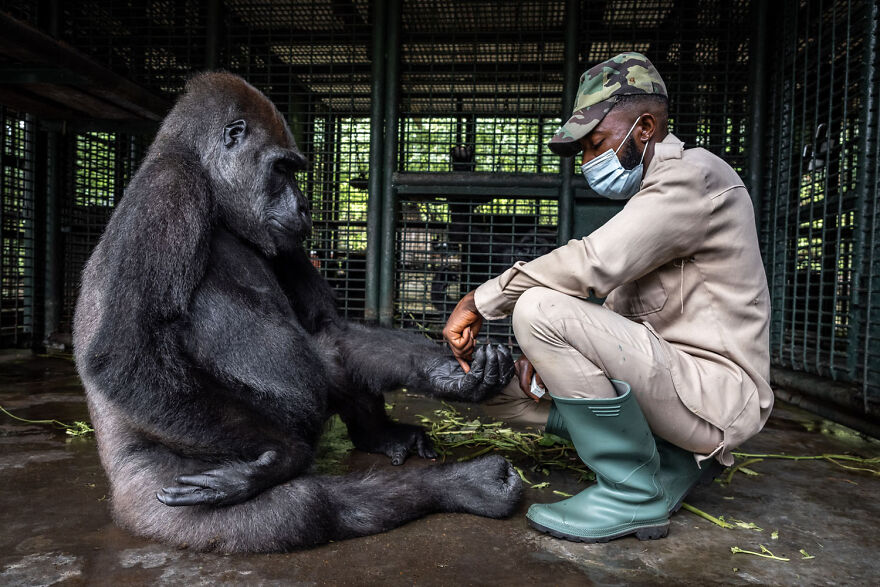
Twiggs, an orphaned female lowland gorilla (Gorilla gorilla), was rescued from being sold as a pet at a Cameroon market in 2003. She was traumatised and had a disabled arm due to a lesion that probably occurred when her mother was killed by hunters. Since her arrival at Limbe Wildlife Centre, Twiggs has been rehabilitated by a devoted team of caregivers who spend more time with her than with their own families. In the photograph, the now adult gorilla is receiving physiotherapy from Cyrile, one of the few people she trusts. Cyrile also found refuge at the sanctuary after being forced to flee his village with his little brother and quit his university studies when a rebel group caused disruptions. Cyrile was studying forestry engineering with the aim of working in wildlife conservation.
Tow souls who needed each other.
When asked about the biggest challenges he faced while shooting in the forest—especially given the delicate ecosystem and the vulnerability of the butterflies’ habitat—Jaime responded: “Working in such a sensitive environment requires great care and respect for both the habitat and the butterflies. The oyamel fir ecosystem is fragile, and monarchs are highly sensitive to changes in temperature, light, and human presence. The local communities play a crucial role in regulating visitor access to the sanctuaries, ensuring the protection of this unique space. For this project, I had to obtain several special permits, which made me even more aware of the privilege it is to work in these sanctuaries. I always prioritize minimizing my impact, often working under challenging conditions to ensure the environment remains undisturbed. I am deeply grateful for the support I’ve received from the keepers of the land and the managers of the protected area, who have made this work possible.”
Underwater World, Highly Commended: Giant Pacific Octopus By Andrey Shpatak
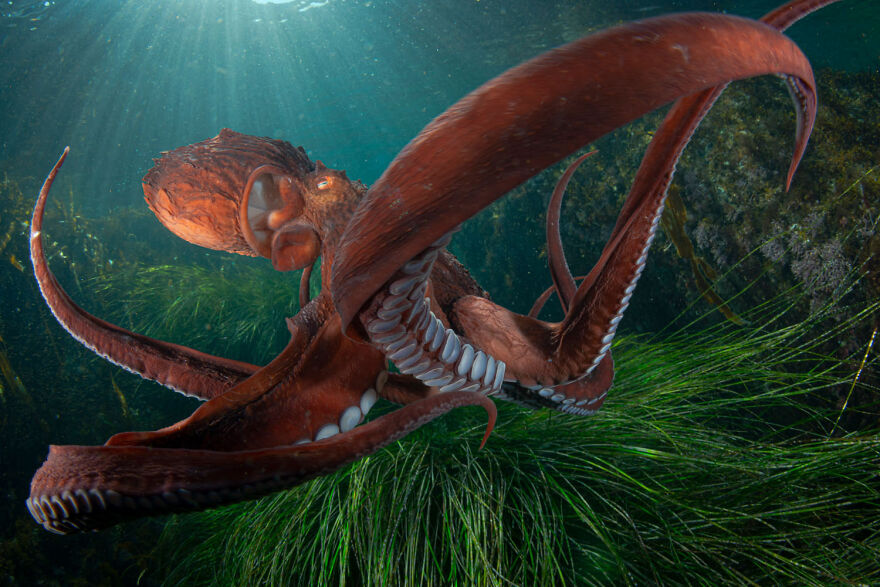
Every year in autumn when the water cools down to around five degrees Celsius, giant Pacific octopuses (Enteroctopus dofleini) migrate to shallow waters. During a morning dive near the Russian town of Rudnaya (Sea of Japan), I came across this imposing individual. Although the octopus fled immediately, I did manage to get a few shots against the backdrop of bright green tufts of seagrass (Zostera marina).
